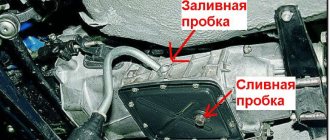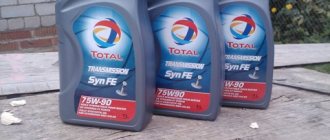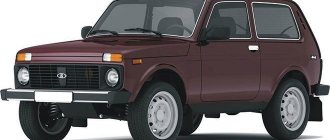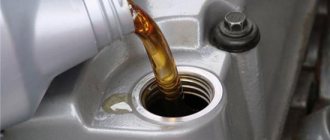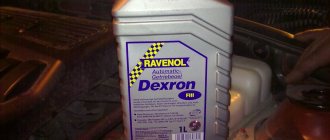Using high-quality transmission fluids for any vehicle is the main factor in preventing malfunctions and extending its service life. Over time, the lubricant loses its protective properties. Therefore, correct and timely oil changes in all transmission mechanisms will be the key to reliable operation of the vehicle. The oil in axles in a Chevrolet Niva can be changed either at a service station or with your own hands if you have some experience.
How to change oil in Chevrolet Niva axles
High-quality oil covers the surfaces of mechanisms with a protective film. At the same time, the coefficient of friction is reduced and heat is better dissipated.
A special feature of the all-wheel drive Chevrolet Niva transmission is the presence of two axles: front and rear. This allows the car to easily overcome off-road conditions. But the need for quality service is additionally increasing.
The presence of two bridges in the Chevrolet Niva allows you to overcome off-road conditions with ease.
5.7.2 Checking the tightness of the rear axle seals
Check the tightness of the seals by external inspection. It is more convenient to check from below the car, mounted on a lift or inspection ditch. Listed below are places where oil may leak.
1. Drain plugs 1 and filler 2 holes.
NOTE If oil leaks from under the plugs, tighten them.
2. Connector on the gearbox flange.
NOTE “Sweating” around potential leakage areas is acceptable. The formation of droplets is not allowed.
USEFUL TIPS If oil leaks from under the gearbox flange, tighten the bolts securing the gearbox to the rear axle housing. If there is oil leakage from under any gearbox mounting bolt that is not corrected by tightening the bolt, install a soft metal (aluminum) washer under the head of the bolt or apply a thin layer of sealant to the threaded part of the bolt.
3. Drive gear oil seal.
4. If the axle shaft seal fails, it leaks here.
5. Oil leakage from the seals can be caused by a clogged breather (see “5.7.1 Design features of the rear axle”). If traces of oil leakage are found, clean the breather from dirt, check the freedom of movement of the breather cap in all directions, carefully wipe the leakage areas and inspect them again after driving 20–30 km. If traces of leakage are found again, it is possible that the breather is clogged and in the rear axle crankcase, when it heats up during operation, pressure increases, squeezing oil out of the seals. Unscrew the breather and clean it. If, even after cleaning, oil leaks from the seals are observed, replace the breather, as it may be faulty (the valve is stuck). If even if the breather is working properly, oil still leaks from the seals, replace the seals.
Changing oil in transmission units
Before starting work, you need to stock up on a sufficient amount of transmission.
Each of the units holds the corresponding volume:
- Gearbox - 1.6 l;
- Transfer case - 0.79 l;
- The front and rear axles are 1.15 and 1.3 liters, respectively.
You can immediately buy 5 liters of 80W-90 transmission that meets the GL4/GL5 quality standard. It is suitable for all transmission units.
It is also necessary to stock up on flushing oil, which allows you to get rid of oxidation products and decomposition of lubricant components.
Changing the gearbox oil
To carry out the work you will need:
- wrench 17;
- container for collecting waste;
- hexagon 12;
- funnel;
- clean rag.
The transmission is replaced on an overpass or inspection pit. Otherwise, it will be difficult to get to the drain plug on the Chevy Niva gearbox. Order of operations:
- Warm up the engine to operating temperature. In this case, the oil will have proper fluidity and will completely drain from the crankcase.
- Place a container for collecting waste under the gearbox drain hole.
- Use a rag to clean the areas around the drain and fill plugs.
- Using a 17mm wrench, unscrew the oil filler plug. This will allow air to enter the gearbox housing.
- Use a hexagon to unscrew the drain plug.
- Wait for the entire transmission to drain from the crankcase.
- Use a rag to clean any chips from the magnetic drain plug.
- Fill in a liter of flushing oil.
- Start the engine and let it run for 3-5 minutes. At this time, you can change gears by squeezing the clutch.
- Stop the engine and drain the flushing oil.
- Tighten the drain plug.
- Using a funnel, pour new transmission oil into the drain hole.
- Screw in the filler plug.
- Start the engine and let it run for 5 minutes.
- Stop the engine and check the oil level. If necessary, top up the transmission.
Video instructions for changing the oil in the Shnivy gearbox:
Replacing the transmission in the transfer case
In addition to the keys, rag and waste container listed in the previous section, you will need a refill syringe. The oil in the transfer case is changed when the engine is warm. There is no need to change the transmission oil on a street overpass in the cold - the fluid will quickly cool down, thicken and not completely drain from the transfer case.
- Place the machine on an inspection pit or overpass.
- Inspect and, if necessary, clean the ventilation valve.
- Clean the box around the plugs.
- Place the waste container.
- Unscrew the filler and drain plugs.
- Drain the transmission.
- Clean shavings from the magnet.
- Screw in the drain plug.
- Using a filling syringe, fill the transmission into the transfer case.
- Screw in the filler plug.
Replacement in Chevrolet Niva axles
Considering the location of the filler holes, you need to unscrew the plug with a socket head and a wrench, and not with a regular wrench. Otherwise, the set of required tools and materials is the same as that needed to change the oil in the transfer case:
- 3 liters of gear oil;
- hexagon 12;
- rag;
- refill syringe;
- container for processing.
The procedure for replacing the transmission in the front and rear axles looks like this:
- Drive the car onto an inspection hole or overpass.
- Clean the oil drain and fill plugs, as well as the axle housing near them, with a rag.
- Place a waste container under the drain hole.
- Unscrew the drain plug one by one.
- Wait until the oil stops leaking.
- Screw in the drain plug.
- Fill the transmission into the bridge using a filling syringe.
- Screw in the filler plug.
Changing transmission oil does not require special skills and abilities. Even a novice driver with no car repair experience can perform this operation. You just need to follow the instructions described above and be sure to fill the transmission with the appropriate viscosity and quality.
voice
Article rating
What to choose for bridges
In most cases, the oil chosen for axles is the same as for the transfer case. Their full compliance guarantees you high functionality of all components of the transmission during active daily use of the car. Most car enthusiasts agree that you should only buy proven lubricants. These include products from the following brands:
This is a list of the most popular and widely used brands. Their products are used by a huge number of car enthusiasts with different experience levels. When purchasing, be sure to check the compatibility of the viscosity and chemical composition with the oil already used in the gearbox.
Changing the oil in a Chevrolet Niva gearbox
To change the oil in a Chevrolet Niva gearbox, you will need the following tools:
- steel hex key 12;
- wrench 17;
- container for draining used lubricant.
The sequence of actions for changing the oil in the Niva gearbox is as follows:
- Place the car over an inspection hole or drive it onto an overpass for ease of work. Before draining the old transmission oil, it is necessary to warm up the engine. This is necessary in order to drain the oil from the box as much as possible and without residue.
- Lower yourself into the inspection hole and place a container under the drain hole, taking into account the bend of the exiting stream. It is convenient to use a funnel.
- Clean the locations of the filler and drain plugs on the gearbox, as shown in the photo above.
- First, it is better to unscrew the filler plug, and then the drain plug using a hexagon.
- Now you need to wait until all the used oil has drained to the last drop.
- The drain plug has a special magnet to which all metal shavings are attracted. If there are steel particles on the plug, they must be removed. And another important point from a diagnostic point of view - the more of these particles are present on the cover, the less the gearbox will last.
- When the old used oil is glass, you need to screw in the drain plug and start flushing the crankcase. To do this, you need to fill in about 1 liter of special flushing fluid and let the car run for 2-3 minutes. In this case, you need to turn on neutral in the transfer case and change gears with the clutch.
- Next, the flushing liquid is drained in the same way and new oil is poured in its place in the required volume.
- After filling the oil, you need to check its level on a level surface and start the engine. It is necessary to let the engine run in first gear for 2-5 minutes. After this, the oil level is checked and if it has dropped, then you need to add a little more.
Also interesting: Repair of transfer case on Niva 21213, how to center it, do-it-yourself adjustment
Transfer case
This is another important transmission unit of the Chevrolet Niva. It includes a range multiplier and a lockable center differential. The transfer case also changes the amount of torque, but not in the same way as the gearbox. In addition, it distributes it between the axles, front and rear, maintaining a 50:50 ratio. The differential is locked to improve maneuverability if road conditions are very difficult.
The transfer case (in the picture its lever is 2) can be switched similarly to a gearbox, only the purpose of the lever shifts is completely different. There is a neutral position (NII–V). There is a high gear (HI) used for normal road conditions, with the differential unlocked. If it needs to be blocked, transmission (HIV) is activated. In difficult areas, the lever switches to LIII if the differential does not yet need to be locked. If it’s really difficult to drive, you need to switch to LIV, blocking the bridges between them. The wheels then rotate at the same speed.
You can switch from the Low position (L - low gear) to the High position (H - high gear) while driving. In this case, you should squeeze the clutch twice, because the transfer case does not have synchronizers. Switching from H to L positions is only possible after the vehicle has stopped. In addition, you cannot lock the differential at high speeds, as you can lose control of the car when cornering. The transfer case uses the same gear oil that is used for the gearbox.
What kind of oil and how to pour it into the transmission, gearbox of Chevrolet Niva (Chevrolet Niva)
The Niva Chevrolet transmission needs to be refilled with new oil regularly; this work is classified as scheduled maintenance. The safety and comfort of driving a vehicle depends on many factors, and compliance with maintenance rules plays an important role. Therefore, transmission fluid must be selected correctly and replaced in a timely manner. The procedure is quite simple, you can do it yourself
It is important to understand the sequence of actions and strictly follow it. Violating the manufacturer's recommendations on the choice of lubricant is contraindicated; this can lead to rapid breakdown of the gearbox, axles, and gearboxes.
Chevrolet Niva gearbox breather repair instructions
Reasoning of a car owner named Vintsas: Low gasoline consumption - 6.5 - 7 liters per 100 km highway (at a speed of 100 - 120 km/h, after 130 km/h consumption increases to 8 l/100 km) Build quality and interior ergonomics - everything is convenient, at hand, nothing breaks unless you break it on purpose. Trunk capacity (not bad for a sedan) Confident dynamics for both the highway and the city. Accelerated up to 170 km/h on a toll highway - there was still room for more Clear suspension operation and excellent handling Excellent gearbox - after the Chevrolet Lacetti you understand that the Passat is the standard High ground clearance - the SUV didn’t pretend to be, but it storms any curbs, it walks confidently on an unclean road , you are not afraid to go to the side of the snowy road. The bottom touched only a couple of times along the deep rut of a country road, without consequences for the car.
Category: Repair yourself
Vehicle characteristics: The vehicle dimensions are as follows: body length - 3936, width - 1100, height - 1233 mm. The wheelbase is 2398 mm. Ground clearance 188 mm. The car is equipped with a hybrid power unit. The 4-cylinder engine is equipped with a system that provides engine power output. There are 4 valves per cylinder. The diameter of one cylinder is 76 mm, the piston stroke is 77 mm. The engine crankshaft accelerates to 2000 rpm. Maximum torque is maintained up to 3000 rpm.
Posted by admin: at the request of Pafnutiy
Views: 2398
Original name:
Release date: 10/19/2022
Duration: 5:22
Quality: WP
Laughter in the topic: The flight attendant turns to the Russian: - Your neighbor is wondering if you took his watch. Russian: - Yes, why the hell do I need it! The flight attendant translates: - Yes, he needs it for his penis. The American nods understandingly: - Ahhh, well then let him wear it!!!
Front axle gearbox
The front gearbox of Niva 21213 differs from the rear gearbox: location, mounting method and design. In order to dismantle it, you will have to lift the car. Further analysis proceeds according to the following scheme:
- Remove the front axle suspension extension (unscrew both fasteners).
- Unscrew the adjusting hub nut and remove the lower shock absorber mount.
- Install the stop and release the ball joint (lower) from the lever.
- Pull out the shank.
- Unscrew the engine support and the axle mounting.
- Unscrew the fastening of the inner joint bearing cap and crankcase bracket to the bridge.
- Pry off the cover and remove the housing from the gearbox.
- Using a support, separate it from the left engine bracket and the cylinder block. Remove the gearbox from the front axle mountings.
After this, you can disassemble the gearbox itself and accurately determine the nature of the damage.
What kind of oil to fill in Chevrolet Niva axles
For maximum functionality of transmission components, it is recommended to fill the axles with the same oil as the transfer case.
Chevrolet Niva owners agree that for axles it is necessary to choose lubricants from well-known brands that have already proven themselves. These include products from manufacturers:
- Mobile,
- Castrol,
- Lukoil,
- Shell,
- Zeke.
But when choosing, you should still observe the compatibility of the composition and viscosity of the oil.
In 90 percent of cases, the Chevrolet Niva is operated off-road, which places high loads on all components of the transmission. And therefore, already at 20 thousand kilometers it is necessary to change the oil, or at least control its quality.
During maintenance, you should soberly assess the condition of the gearbox, transfer case and axles. You should not skimp on lubricants, as this can lead to quite expensive repairs.
Selection of oil for transfer case
In order to choose the right lubricant for the transfer case, several factors should be taken into account. One of the most important is compatibility with other liquids used. Before purchasing, be sure to check the viscosity of the lubricant. At the same time, it is not at all necessary to purchase products from one manufacturer. It is also not recommended to use lubricants with different chemical compositions so that they do not mix. This is very important if you want to truly improve the performance of your car. Therefore, if you fill a Chevrolet Niva with semi-synthetics, then in the case of the transfer case, purchase a semi-synthetic lubricant.
Replaced engine and transmission oil
Having bought a Chevrolet Niva and driven it for three months (just before winter), I decided to immediately change the oil, although the previous owner claimed that he had changed the oil recently. But why take the risk? It’s better to replace it immediately to be sure. For the heap, I decided to replace the transmission, as they say - just to be sure.
I started looking for information on the Internet and my eyes began to run in different directions - some praise this oil, others - that one, and still others - only the most expensive. In short, for an inexperienced beginner it was a guard.
What was recommended:
Mobile 1 Shell Liquid Molly Castrol
Zeke
Engine
As a result, for the engine I took 4 liters of Shell 10W40 semi-synthetic, the cost is 1150 rubles. For the money it’s quite excellent, and I haven’t heard any bad reviews about the shell, I called a friend, he also advised me to take the shell. As a result, having skated through the winter, I can give my review of this oil:
The maximum was to start without any shamanism at -28, when the frost dropped below 30, I didn’t take risks and didn’t ruin the car, but took a taxi and I advise everyone. Although, if you warm it up at night, you could start it in the morning without any problems, especially since I also bought a more powerful battery.
Update!
Having checked the oil level not long ago, I was shocked - it was almost gone. Fuck, that means the car eats oil, and with bread)) I had to stomp to the store and get another bottle. I took Shell Helix HX7 half blue again, 5W40, like this:
In terms of money it came out with a funnel of 1250:
I took the funnel, because the last time I was tired of pouring without it - when the canister is full, you pour oil on the engine, then it burns and you understand, no ice. And this is simply beautiful, I recommend it. It seems to be for gasoline, but it fits perfectly into the neck of the engine and there is a mesh so as not to fill it with debris.
In principle, I took it to top it up as soon as I bought the car. I drove it for 2 months and then changed to Shell. Why? Well, I don't know, I read the reviews, they say it's shitty oil. In 2 months you won’t really get a feel for whether it’s normal or not. There was nothing suspicious with the car, the engine sound was smooth. Now I drive a Shell - the sensations are identical. Of course, if you drive for 3-4 years on one oil, take the engine apart and look, and then on another and look again, you can see the difference with your eyes)) And so, the main thing is to change it more often and everything will be fine. I change it very often for now)) I’ll take it to the service center and let them find out why the oil is being consumed, because it’s no good buying a 4-liter bottle every six months))
Transmission:
Front axle Rear axle Gearbox
Razdatka
75v90 will be thinner than 80v90, so it is better for winter. The first number is viscosity in summer, the second – in winter. Synthetics are thinner, mineral water is thicker.
Some people pour different oils into axles and gearboxes - thicker ones for axles, thinner ones for gearboxes. Most people don’t give a damn and pour the same into the bridges and boxes - that’s what I did.
If you plan to often cross small rivers in the summer, then synthetics will be greatly diluted with water. Therefore, in such cases - mineral water. You can also put half blue in the box.
For the transmission and gearbox, I filled it with inexpensive TNK 75W90, also semi-synthetic, 4 liters, cost 1170 rubles. (The mineral water becomes tanned, so if for frosts, half-blue will be just right). True, I didn’t fill it myself, but in a workshop. They charged 1200 for the work - changing the oil in the front/rear axles, in the manual transmission and in the transfer case - 300 rubles each. As they say, it’s easy and quick, otherwise I would have spent a lot of time if I didn’t know. And to me time is more valuable than money.
The craftsmen there advised to fill TNK, one Niva, so he says that he constantly pours this and normal. At first I wanted to put something more expensive into the transmission, but then I changed my mind. I drove it for a drive over the winter - everything was a bunch, below -28 I didn’t even try to start it, because I feel sorry for the car. And so - very good. And inexpensive. If it’s more expensive and cooler, then only SHELL SPIRAX is an excellent oil.
Also, was there any parking in terms of GL-4 or GL-5? I did some digging and found out that GL-5 contains some special “extreme pressure” additives, which are very harmful to non-ferrous metals. In general, as I understand it, the GL-5 will be better for the Niva and Chevrolet Niva axles and for the transfer case. I took it))
By the way, I also read that some people add CV joint-4 lubricant to the transmission oil. There are other special additives, the very popular Xado additive.
In general, this is how I changed the oil in my Chevrolet Niva, I’ve been driving it for 4 months in the winter, the flight is normal. True, I didn’t even try to start it in severe frosts, so if you plan to drive at minus -30-40, then fill it with something thinner.
xtreme-trip.ru
Changing the oil in axles (thriller) - logbook of the 2013 Chevrolet Niva Countess Chevy on DRIVE2
Last weekend I sat in puddles, but the breathers were not removed... So I had to change the oil. By the way: in the rear axle there was literally no emulsion at all, in the front axle there was a maximum of 5 ml. But what leaked out of the axles... The point of the whole entry: two weeks I stopped by the service center back and asked to change the oil in the axles along the way (it’s still not very convenient to do this in a garage without a pit and a lift). But since I was sitting in puddles (I repeat), it was decided to change the oil myself this time. So, ... The rear axle leaked: a) little oil; b) black-black. Changed it. On the front axle it’s even more interesting! They changed the drive seal - and in theory they should have changed the oil too. And so they wrote it down in the work order, and also wrote down the removal and installation of the protection. I didn’t see any traces of the protection being removed, and the oil was also black. It's sad... Lately, the higher the rating of a service, the worse the work done. It turns out that they didn’t change my oil 2 weeks ago. If you want it done well, do it yourself. Now I filled it with TNK 75W90 GL5 - the car has been transformed, the knocking in the transmission has gone to almost zero. The gaps are noticeably softer and more pleasant to select.
And about 10 kg of healing mud was removed from under the engine protection.))))
A small life hack: when changing the oil in the rear axle, I used a 25 cm long hose + a funnel (at the bottom there is a place to warm up with a liter canister), with the front axle it’s easier - a hose of about 80 cm with a funnel, but the hose stands vertically (up), the funnel Accordingly, it turns out to be convenient to pour in the area of the valve cover.
Issue price: 800 ₽
Gearbox oil, technical characteristics, decoding of gear oil markings
Chevrolet Niva uses transmission oils that have the following parameters:
For most car owners, the meaning of these numbers is unclear, because the labeling of motor oils has a completely different abbreviation. Let's try to figure this out.
Like motor oils, transmission oils come in winter and summer grades. The symbol “W” in the viscosity class designation stands for “Winter”, that is, “Winter”. This indicates that these types are intended for winter use, however, this does not mean that they cannot be used in the summer. Summer oils are used in countries with warm climates, but, as you know, in Russia it is more often cold than warm.
SAE is a generally accepted classification of gear oils, consisting of nine viscosity levels. The numbers presented in the table above indicate the temperature ranges of application. Thus, 75W-90 is allowed for operation at temperatures -40 - +35, 80W-85 - at temperatures -26 - +35, and 85W-90 - at temperatures -12 - + 35. Based on this, every car owner has the opportunity to select the required lubricants for their car model.
Classification according to API is also generally accepted. These standards divide oils into groups, depending on operating conditions and type of design. According to the API system, transmission oils are designated by the letters GL and numbers 1-5. It is worth noting that the higher this figure, the harsher the operating conditions of lubricants.
As you know, the Chevrolet Niva is designed to work in off-road conditions. This means that the vehicle mechanism, in particular the gearbox, is under serious stress. If a lubricant with a lower operating category is poured into the gearbox, then already under the first load conditions there will be a need to replace the gearbox.
Before purchasing oil, follow these recommendations and tips:
Review the vehicle manufacturer's recommendations. The use of more expensive oils is not always justified, since their properties can negatively affect the performance of the lubrication system itself
Therefore, it is important to give preference to lubricants from the recommended range. Change the transmission oil regularly. Do not allow the lubricant level to drop and constantly monitor the level. In vehicles with high mileage, change the gear oil much more often, since the gearbox mechanism is exposed to more severe operating conditions. Today, there are many manufacturers of gear oils, differing only in the stickers on the packaging
It is not recommended to fill in mineral types of oils, since in severe frosts they can freeze, which cannot be said about semi-synthetics. It is worth noting that among inexpensive gear oils, the first place in quality is taken by TNK, whose price is approximately 280 rubles per liter
Today there are many manufacturers of gear oils, differing only in the stickers on the packaging. It is not recommended to fill in mineral types of oils, since in severe frosts they can freeze, which cannot be said about semi-synthetics. It is worth noting that among inexpensive gear oils, the first place in quality is occupied by TNK, whose price is approximately 280 rubles per liter.
Among the more expensive oils, we can highlight Shell Spirax, the price of which is 600 rubles
However, what is important is not what kind of lubricant you pour into the gearbox, it is important that it matches the operational characteristics of the vehicle
Modern realities
What kind of engine oil should I put in my favorite Chevy? Despite the fact that the Chevrolet Niva belongs to the category of indestructible domestic cars, not every product can be filled into it. The first thing to consider when choosing a new fuel and lubricant is the temperature conditions under which the car will be operated. The second point is the money you are willing to spend on motor lubricant.
It is not recommended to pour mineral oils into a Chevrolet Niva. Such products have long become obsolete and cannot boast of high quality characteristics. Such fuels and lubricants burn out very quickly and cannot provide proper lubrication to the parts, which in turn leads to their rapid wear, increased fuel consumption and additional costs.
Synthetics are a completely different matter. Additives are added to the engine oil, which ensures high-quality lubrication of all engine elements. In addition, the service life of the engine is significantly increased, and the level of fuel consumed is reduced. Synthetics are not afraid of severe frosts - the Chevrolet Niva will start easily even at -40°C, which is especially valuable in Russian realities.
Chevrolet Niva requires systematic oil, which must be replaced after every 10,000 km. But it is possible that replacement will be required earlier - it all depends on the operating conditions of the car.
Many Chevrolet Niva owners have abandoned the use of domestic oil in the engine. This fact is associated with frequent counterfeits of domestic products. To buy truly branded fuel and lubricants, you need to buy lubricant only in specialized stores that specialize in selling petroleum products.
Changing the oil in Chevrolet NIVA axles
Using high-quality transmission fluids for any vehicle is the main factor in preventing malfunctions and extending its service life. Over time, the lubricant loses its protective properties. Therefore, correct and timely oil changes in all transmission mechanisms will be the key to reliable operation of the vehicle. The oil in axles in a Chevrolet Niva can be changed either at a service station or with your own hands if you have some experience.
How to change oil in Chevrolet Niva axles
High-quality oil covers the surfaces of mechanisms with a protective film. At the same time, the coefficient of friction is reduced and heat is better dissipated.
A special feature of the all-wheel drive Chevrolet Niva transmission is the presence of two axles: front and rear. This allows the car to easily overcome off-road conditions. But the need for quality service is additionally increasing.
The presence of two bridges in the Chevrolet Niva allows you to overcome off-road conditions with ease.
When to change
For prevention, according to the manufacturer's instructions, you should periodically change the lubricant of both axles of the car every 45 thousand kilometers or after three years of operation. If the machine is often used off-road or at low temperatures, then this interval should be reduced. Also, the appearance of external disturbances in the operation of the transmission, caused by a whistle, increased hum, knocking when starting from a stop and at speed, signals the need to check the level and quality of the transmission fluid.
After purchasing a used car, after major repairs, you also need to change the lubricant. The longer the mileage becomes (especially after 100 thousand kilometers), the more often such maintenance should be carried out.
Which oil should you choose?
Experienced drivers know what kind of oil to pour into Niva axles and how much of it is required. The oil poured into the rear axle gearbox is the same as into the front axle. For axles, according to official instructions, lubricant type 80W90, 85W90 with API specification GL-5/GL-4 is required. It is advisable to change the oil to a product of the same type and manufacturer. Choose from reliable manufacturers of well-known brands: Lukoil, Shell, Castrol, TNK, etc. You can also use the popular universal lubricant 75W90.
Choose oils from reliable manufacturers
To carry out the replacement procedure, the following volume of fluid is required:
- front axle housing – 1.15 liters;
- rear axle housing – 1.3 liters.
Preparing for replacement
The process of changing the lubricant yourself will take a little time - an hour or an hour and a half. But you need to prepare first. A set of tools, devices, and consumables is selected. You will need a 12mm hex key and a 17mm socket head, a container for waste fluid, dry rags, and sealant. For filling, you can use a special filling syringe (pump) or another device (funnel with hose). Copper sealing rings are placed on the crankcase plugs. Therefore, you need to prepare them in advance. Work is carried out with protective gloves.
Carrying out an oil change
Let's look in detail at how to change the oil in axles. The main steps of the procedure are identical to changing the lubricant in the transfer case. First, the fluid in the gearboxes warms up. To do this you need to drive about five kilometers. Then the car is driven onto a viewing hole, overpass or lift. The waste is poured into prepared containers. Its condition is assessed for the presence of dirt and metal particles. New lubricant is added. Possible leaks are checked. You also need to clean the breathers of both bridges. The filler holes are inspection holes for checking the lubricant level. The liquid should be level with these holes.
Oil is filled with a special syringe
Changing the oil in the front axle gearbox
Changing the oil in the front axle of a Chevrolet Niva with your own hands is done in the following order:
- Unscrew the drain plug with a 12mm wrench and completely drain the waste into the prepared container. Remember that the liquid is hot.
- Clean the plug and the edges of the hole, replace the gasket, and lubricate the whole thing with sealant.
- Replace the drain plug.
- Unscrew the filler plug with a 17 key. The filler hole is located on the left side in the direction of travel.
- Fill in the lubricant with a special syringe or device.
- Screw in the filler plug.
- Check for leaks. This completes the transmission fluid change.
Changing the oil in the rear axle
Changing the oil in the rear axle is carried out in the same sequence. Only the volume of liquid poured will differ.
Changing the oil in Chevrolet NIVA axles Link to main publication
Changing the oil
Replacing fuel and lubricants in Niva is practically no different from changing lubricant in any other car. All work can be done with your own hands, without contacting service station employees.
To work you will need:
- Not less than 4 l; Hexagon; To remove the oil filter, you will need a special wrench; Container for used lubricant; New filter; Funnel, rags and brush.
Now, you can safely begin the work:
- Remove the plug from the neck; Unscrew the cap from the grease filling hole; Remove the crankcase protection; We place the prepared empty container under the drain hole; Remove the plug and then unscrew the drain cap; We wait until the used oil is completely drained; Remove the old filter; Fill the new filter about 1/3 full with oil; Fill the engine with new oil; We tighten all the covers and install the plugs in place; We check the plugs with the engine running - there should be no leaks anywhere; After the car has been running for several minutes, we take a control measurement of the level using a dipstick; That's it, the oil is filled.
Results
In most cases, the Niva is used for off-road driving, which puts a lot of stress on the transmission. Therefore, it is optimal to change the oil after a mileage of 15–20 thousand kilometers. Do not save where it is fraught with bad consequences. When performing vehicle maintenance, evaluate the condition of all engine components, and also change filters and spark plugs at least once every two oil changes.
The transmission on a Chevrolet Niva requires careful care and oil changes according to the manufacturer's regulations. But we’ll try to figure it out in this article about which oil is best to fill.
Transmission oil tolerances
To begin with, you need to indicate what tolerances and viscosity the manufacturer recommends. So, in order:
- Manual transmission
– SAE 75W90, 80W85, 80W90. - Transfer case
- SAE 75W90, 80W85, 80W90. - Front and rear differential
–75W90, 80W90, 85W90.
For front and rear axle gearboxes according to API GL5, or GL4/GL5 (simply GL4 is not allowed).
It should be remembered that by observing these tolerances and changing the oil on time, you can extend the service life of the units
, as well as reduce the noise of their operation. Unfortunately, the noise of the gearbox and the howling of the bridges are a typical case for a domestic car.
Transmission oil
Here are some brands of oils that have proven themselves to be proven and well proven.
Eneos 80W90 Gear GL5
Transmission oil ENEOS 75W90 GEAR GL-5, 4 l
From positive reviews and advantages: stable retention of fluidity in harsh conditions of low temperatures (-30 C). The disadvantages include the presence of only 4-liter containers.
Castrol Syntrax Universal Plus 75W90 GL4/GL5
Castrol Syntrax Universal Plus 75W90 GL4/GL5
Perhaps the main advantages include the replacement interval, about 300,000 km in the gearbox. Provides smoother operation of the transmission and reduces operating noise. Disadvantage: relatively high price.
Mobil Mobilube HD 75W90 GL5
Mobil Mobilube HD 75W90 GL5
Relatively low cost with good quality from a famous brand, no special comments on the oil, quite a popular product.
Shell Spirax S5 ATE 75W90 GL4/GL5
Shell Spirax S5 ATE 75W90 GL4/GL5
Oil for sports cars, also suitable for Chevrolet Niva. It has helped out more than once when complaining about noise from the gearbox/transfer case. Designed for heavily loaded transmissions, recommended for off-road use.
Mobil Mobilube GX 80W90 GL4
Mobil Mobilube GX 80W90 GL4
High-quality oil based on paraffin oils, a modern package of anti-wear additives. No major deficiencies were found.
Motul Gear 300 75W90 GL4/GL5
Perhaps one of the leaders. Copes well with loads throughout the entire rev range. However, you have to pay for quality; the price is quite high.
Owners of domestic VAZ 2121 and 2131 cars should know what gear oil to fill and how to do it correctly with their own hands in a garage? This requires a suitable lubricant and a certain set of tools, and we will talk about this in detail in today's material.
The physical and mechanical properties of various Niva gearbox oils affect their performance properties. Not every car owner understands the intricacies, and determines the oil only by the range of use of a particular product. Experts recommend following a number of criteria when choosing gear oil for Niva:
- the oil must be suitable taking into account the current condition of the gearbox;
- the product must meet the requirements of the car manufacturer;
- suitable for the season of operation of the car;
- gear oil for VAZ 21214 or 21213 must be real.
Preparing for replacement
If you want not to resort to such radical measures as repairing the gearbox, you should constantly monitor the level and condition of the oil in the Chevrolet Niva gearbox. If you notice that the liquid substance has changed color (darkened) or smell (unusual, foreign), you need to change the oil urgently. A good liquid substance that does not yet require replacement will be transparent and viscous. To check, you can rub a drop of liquid with two fingers, thus you can determine the presence of oxol and its condition. The manufacturer of the Chevrolet Niva car says that the gearbox oil should be changed every 45 thousand km - it is worth listening to these indicators.
What kind of oil to pour
Before we tell you how to do the replacement, you will need to buy new transmission fluid. Currently, it is very difficult to choose a suitable substance as the choice is too large, there are many manufacturers, and the difference between their products is insignificant. How to choose the best transmission fluid that will be of good quality and affordable price?
Synthetic oils
The first thing you need to do is identify the climatic conditions, for example, if you live in an area where winters are cold (22-25 degrees), then it will be better for your car to use 5W-40 synthetic oil. Such a substance will not freeze due to the fact that it is very liquid. With mineral oils things are different. In terms of characteristics, they are significantly inferior to synthetics, but their price is more reasonable. We would recommend that you fill the Chevrolet Niva gearbox with synthetic transmission fluid. Synthetics lubricate the engine well, which extends its service life, saves fuel and increases engine power.
